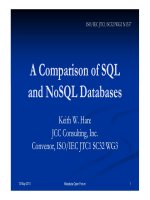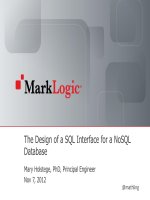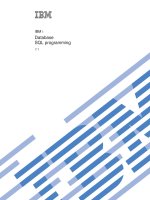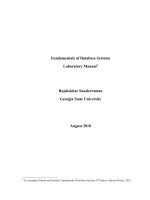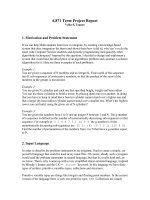TÀI LIỆU - Cao Học Khóa 8 - ĐH CNTT 5. cNoSQLDatabase
Bạn đang xem bản rút gọn của tài liệu. Xem và tải ngay bản đầy đủ của tài liệu tại đây (1.84 MB, 46 trang )
The Design of a SQL Interface for a NoSQL
Database
Mary Holstege, PhD, Principal Engineer
Nov 7, 2012
Slide 1
Copyright © 2012 MarkLogic® Corporation. All rights reserved.
@mathling
Topics
§ MarkLogic: Enterprise NoSQL Database
§ SQL over NoSQL, What’s The Point?
§ How Does It Work?
§ Technical Nitty Gritty
§ Q&A
Slide 2
Copyright © 2012 MarkLogic® Corporation. All rights reserved.
MarkLogic
NoSQL Database
ü Shared-nothing
ü Clustered
ü Non-relational
ü Schema-free
ü Scalable
Host 1
Host 4
partition1
Slide 3
Copyright © 2012 MarkLogic® Corporation. All rights reserved.
Host 2
Host 5
Host 6
partition2 partition
partition
3
4
Host 3
Host k
partitionm
MarkLogic
Enterprise NoSQL Database
ü ACID
ü Real-time full-text search
ü Automatic failover
ü Replication
ü Point in-time recovery
ü Government-grade security
Slide 4
Copyright © 2012 MarkLogic® Corporation. All rights reserved.
Keep This In Mind
§ Non-relational data model
§ Documents (XML, JSON, binary, text)
§ Rich “query” language (XQuery+extension functions)
§ Really a complete language for application development
§ Search engine core
§ Full-text
§ Hierarchical, structure
§ Geospatial
§ Values
Slide 5
Copyright © 2012 MarkLogic® Corporation. All rights reserved.
What’s the Point?
Slide 6
Copyright © 2012 MarkLogic® Corporation. All rights reserved.
MarkLogic and BI Tools
§ Use familiar relational tools with non-relational data
§ Such as BI tools
§ Standard connection – no code, no custom integration
§ All the benefits of a BI tool – data analysis, visualization - with
an operational Big Data database
Slide 7
Copyright © 2012 MarkLogic® Corporation. All rights reserved.
Structured and Unstructured Data
Personal Info
Aliases
Phone numbers
Bank accounts
Credit cards
Vehicles
§ MarkLogic’s XML data model was designed to handle rich
structured and unstructured data
Slide 8
Copyright © 2012 MarkLogic® Corporation. All rights reserved.
Structured and Unstructured Data
Personal Info
Aliases
Phone numbers
Bank accounts
Credit cards
Vehicles
§ Richness of unstructured content does not fit naturally into a
relational model
Slide 9
Copyright © 2012 MarkLogic® Corporation. All rights reserved.
XML vs Tables and Views
§ Data is stored in MarkLogic as XML
§ Rich, powerful way to represent complex data
§ BI tools expect to see relational tables and views
§ Rows and columns, accessible via SQL
Slide 10
Copyright © 2012 MarkLogic® Corporation. All rights reserved.
How Can This Possibly Work?
Slide 11
Copyright © 2012 MarkLogic® Corporation. All rights reserved.
How Can This Possibly Work?
§ Focus on "structured" pieces of the data
§ Create an in-memory column index on each piece
§ Create a view over column indexes
Slide 12
Copyright © 2012 MarkLogic® Corporation. All rights reserved.
<?xml version="1.0" encoding="UTF-8"?>
date="2010-05-17T01:00:21.627923-08:00">
<headers>
<from personal="Ian Roberts"></from>
<to personal="Grails User"></to>
<subject>How to inject a session-scoped service into another service
</subject>
</headers>
<body type="text/plain; charset=us-ascii">
<url> Covers the
same thing, but has a little bit more detail WRT testing etc.</para>
<function>myServiceProxy</function>(org.springframework.aop.scope.
ScopedProxyFactoryBean){ targetBeanName = 'myService' proxyTarget
Class = true}</para>
intro to proxies.</para>
<footer type="signature" depth="1" hash="1986520897999785197">-<name>Ian Roberts</name> | Department of Computer Science
<email></email>
<affiliation>University of Sheffield, UK</affiliation></footer>
</body>
</message>
Slide 13
Copyright © 2012 MarkLogic® Corporation. All rights reserved.
<?xml version="1.0" encoding="UTF-8"?>
List
<headers>
<from personal="Ian Roberts"></from>
org.codehaus.grails.user
<to personal="Grails User"></to>
From
<subject>How to inject a session-scoped
service into another service
</subject>
</headers>
<body type="text/plain; charset=us-ascii">
<url> Covers the
same thing, but has a little bit more detail WRT testing etc.</para>
<function>myServiceProxy</function>(org.springframework.aop.scope.
ScopedProxyFactoryBean){ targetBeanName = 'myService' proxyTarget
Class = true}</para>
intro to proxies.</para>
<footer type="signature" depth="1" hash="1986520897999785197">-<name>Ian Roberts</name> | Department of Computer Science
<email></email>
<affiliation>University of Sheffield, UK</affiliation></footer>
</body>
</message>
Slide 14
Copyright © 2012 MarkLogic® Corporation. All rights reserved.
DOC
List
List
/mm/21
org.codehaus.grails.user
org.codehaus.grails.user
DOC
From
/mm/21
/mm/57
org.codehaus.grails.user
/mm/57
/mm/99
org.ruby-lang.ruby-core
/mm/99
…
…
…
…
§ Every document has a unique identifier in the database
§ We can map the document identifier to the list name
§ We can do that for every list attribute in every document
§ … and we can do that for any piece-of-structure in the database
§ These look like columns!
Slide 15
Copyright © 2012 MarkLogic® Corporation. All rights reserved.
DOC
/mm/21
List
org.codehaus.grails.user
From
/mm/57
org.codehaus.grails.user
/mm/99
org.ruby-lang.ruby-core
…
…
…
§ Now we can stitch the two "columns" together
§ Using co-occurrence
Slide 16
Copyright © 2012 MarkLogic® Corporation. All rights reserved.
DOC
List
From
Subject
DOC
List i.roberts
/mm/21
grails
How to
/mm/21 org.codehaus.grails.user
/mm/21
i.roberts
How to
/mm/57 grails
org.codehaus.grails.user
URL
Name
..From
Ian
Roberts
Ian
Roberts
/mm/99 org.ruby-lang.ruby-core
/mm/57 grails j.doe
Tips on .. John Doe
…
…
…
/mm/99
ruby
john.louis
New ..
/>
…
…
…
…
…
…
Affiliation
University
of Sheffield
University
of Sheffield
University
of Life
…
§ Now we can stitch the two "columns" together
§ Using co-occurrence
§ When we do that for several structured pieces, it starts to look
like a table
Slide 17
Copyright © 2012 MarkLogic® Corporation. All rights reserved.
MarkLogic as a Columnar Database
V
§ Combine existing capabilities:
§ In-memory distributed indexes
§ Co-occurrence (extended)
§ MarkLogic as an in-memory columnar database
Slide 18
Copyright © 2012 MarkLogic® Corporation. All rights reserved.
How Does It Work?
Slide 19
Copyright © 2012 MarkLogic® Corporation. All rights reserved.
Mapping Unstructured Data
Indexes have typed values, but text is text
§ Rich set of types
§ Numbers (decimal, float, double, …)
§ Strings (string, name, uri, …)
§ Date/time (date, time, timestamp, …)
§ Geospatial (points)
§ But maybe the value has the wrong type
§ Not a real date <date>2001/755</date> ⇒ (nothing)
§ Maybe there is an empty value
§
§ Maybe there is no value at all
§
There is no function here.
⇒ (nothing)Slide 20
Copyright © 2012 MarkLogic® Corporation. All rights reserved.
Mapping Unstructured Data
Indexes can select specific elements or attributes
§ Named element
§ <function>myServiceProxy</function>
⇒ "myServiceProxy"
§ Named attribute of an element
§
§ Multiple values OK
§ <function>myServiceProxy</function> and
<function>myServiceStub</function>
⇒ "myServiceProxy","myServiceStub"
Slide 21
Copyright © 2012 MarkLogic® Corporation. All rights reserved.
Mapping Unstructured Data
Indexes can select concatenated values
§ Concatenated values of specific elements
§ <caption>A <b>good</b> example</caption>
⇒ "A good example"
§ Maybe some children should be skipped
§ <caption>A good example<footnote>Please exclude
this text</footnote></caption>
⇒ "A good example"
§ Conditional inclusion/exclusion based on attribute values
§
This one.
Not that one.
p>
⇒ "This one."
Slide 22
Copyright © 2012 MarkLogic® Corporation. All rights reserved.
Mapping Unstructured Data
Indexes can select complex paths
§ Selecting a targeted structural relationship: section/title
§ <chapter><title>Chapter Onetitle><section><title>Section A</title>...
⇒ "Section A"
§ Selecting multiple related elements: /info/(person|org)
§
⇒ "John Smith","IBM"
§ Selecting based on comparison predicates: person[@age>18]
§
⇒ "John Smith"
Slide 23
Copyright © 2012 MarkLogic® Corporation. All rights reserved.
Mapping Unstructured Data
Indexes can select correlated parts (geospatial)
§ Paired attributes
§
⇒ point(0.1,24.24)
§ Paired elements
§
⇒ point(39.2,-110.44)
Slide 24
Copyright © 2012 MarkLogic® Corporation. All rights reserved.
Indexes
Map document ids to values, and values to document ids
in a compact distributed in-memory representation
DOC ID
Slide 25
YEAR
YEAR
DOC ID
1
2009
2002
3
3
2002
2003
10
4
2007
2004
5
5
2004
2004
11
8
2011
2007
2
10
2003
2007
4
11
2004
2007
17
17
2007
2011
8
…
…
...
…
Copyright © 2012 MarkLogic® Corporation. All rights reserved.


